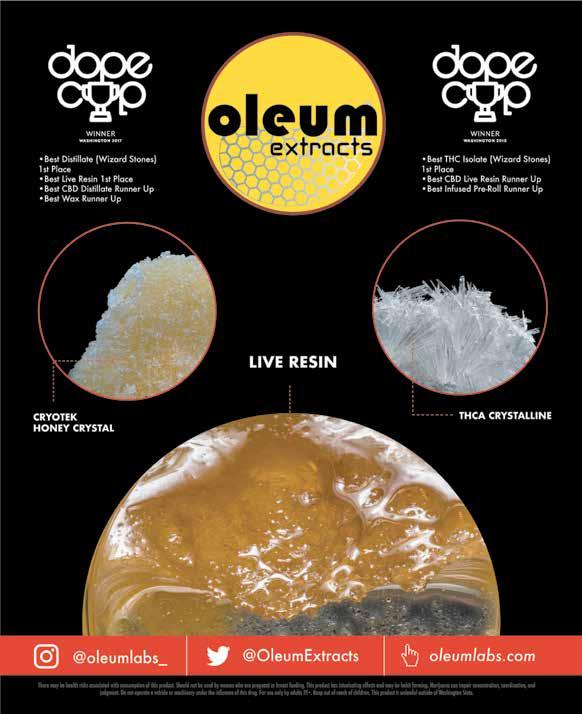

THE STRANGER’S LOFTIEST MAGAZINE • FALL 2018–WINTER 2019


FIVE STRAINS TO TRY RIGHT NOW



THE STRANGER’S LOFTIEST MAGAZINE • FALL 2018–WINTER 2019


FIVE STRAINS TO TRY RIGHT NOW

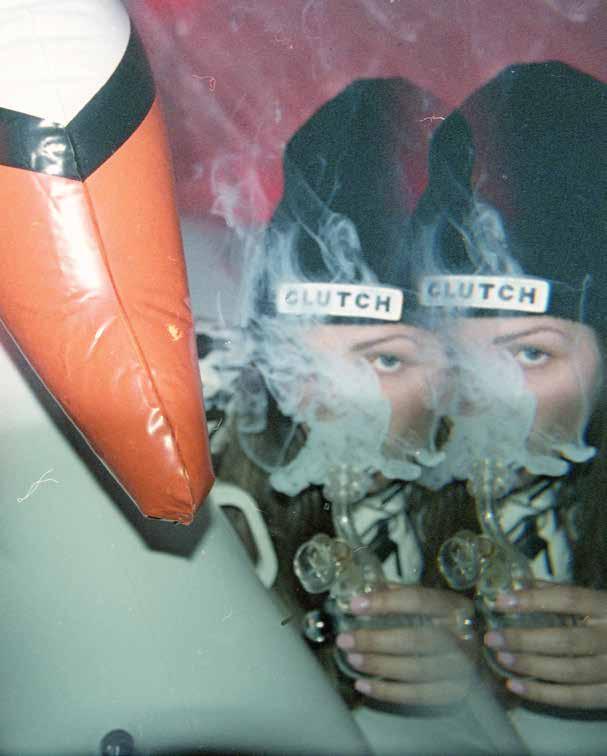




























EDITOR
Leilani
DIGITAL
SALES OPERATIONS MANAGER
Ta y Marler
ADVERTISING COORDINATOR
Bobby Anderson
DIGITAL ADVERTISING
OPERATIONS COORDINATOR Nikoli Shaver
Events & Media
EXECUTIVE PRODUCER
Rob Crocker
DIRECTOR OF OPERATIONS
Tracey Cataldo
MARKETING & PROMOTIONS
DIRECTOR
Caroline Dodge
MARKETING & PROMOTIONS
COORDINATOR
Status Causey PODCASTS
Nancy Hartunian
EXECUTIVES Katie Phoenix, Andi Pistay
SENIOR ACCOUNT EXECUTIVE/ THEATER
Juliette Brush-Hoover ENTERTAINMENT ACCOUNT EXECUTIVE Diana Katz
DISPLAY ACCOUNT EXECUTIVES Neal Callahan, Darci Gatlin
Business
PRESIDENT
Tim Keck
CFO
Rob Crocker
ACCOUNTING MANAGER
Renée Krulich
RECEPTIONIST Mike Nipper
CREDIT MANAGER/ OFFICE MANAGER
Evanne Hall
Technology & Development
CHIEF TECHNOLOGY OFFICER
Anthony Hecht
LEAD DEVELOPER Jay Jansheski
DEVELOPERS
Hannah Balenda, Michael Crowl, Nick Nelson
DIRECTOR OF SALES AND OPERATIONS
Ryan Sparks
CLIENT SOLUTIONS MANAGER
Callan Berry
CLIENT SOLUTIONS
REPRESENTATIVES
Grant Hendrix, Sarah VanSandt
CIRCULATION MANAGER
Kevin Shurtlu
CIRCULATION ASSISTANT
Paul Kavanagh
Publisher Laurie Saito
THE STRANGER 1535 11th Avenue, Third Floor, Seattle, WA 98122 VOICE 206-323-7101 FAX 206-323-7203 SALES FAX 206-325-4865 Mon–Fri, 9 am–5:30 pm editor@thestranger.com




BY MICHAEL BELL
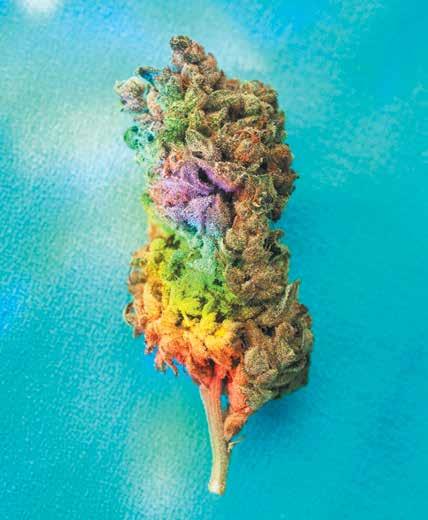
Labrador has a very herbal aroma, somewhat reminiscent of pine and lemon. The back of your nose might pick up notes of aromatic hops. This bud boasts a relatively high terpene percentage of 1.78 percent, predominantly myrcene and pinene, the combination of which carries a musky-rosemary flavor
profile. The smoke is sweet and thick. Raven Grass, whose pot is organically grown in Olympia, describes this weed as a metaphor for an actual Labrador: “friendly, active, outgoing.” From my experience, I would add the adjectives cuddly and comfortable.
I tried Raven Grass’s Labrador on a cool, cloudy Saturday, and it was the perfect complement to my morning dog walk. After lazily wandering around Fremont, admiring some beautiful foliage, I went home feeling the urge to curl up back in bed and watch Netflix.

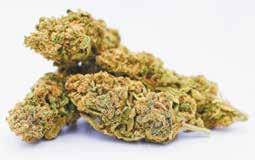
In last fall’s Green Guide, Lester Black recommended the 9lb Hammer grown by Boggy Boon. Now I’m recommending Puffin Farm’s version. Puffin’s 9lb Hammer is a thing of beauty. The nugs are stunningly green and covered in orange hairs, and the smell is deliciously fruity and sweet—a delectable candy.
Plus, the praise I hear for Puffin is practically unanimous, from budtenders and growers, to enthusiasts
and reviewers. Puffin has gone the extra mile in terms of growing green by holding a Clean Green Certification, meaning the farm grows pot according to organic standards. This is one of those strains that tastes exactly as you’d imagine from the aroma, a sign that the flower is expertly grown outdoor bud. The high is contemplative and uplifting—making you appreciate just sitting back and gazing out the window.
These are dense, berry-sized nugs, begging for a proper grinding before being smoked. Pick this pot apart by hand, and you’ll be left with sticky fingers and squished weed. But throw it in a grinder, and its volume will expand into a fluffy mix of delicate aromatics. The smell does the name justice—sweet aromas with a touch of that beautifully earthy weed scent. Based off the density of sticky trichomes, I suspect it would be great for vaporizing.
Sunset Sherbet hits smooth and tickles the tip of the nose. While my body felt a slight heaviness, I was not locked into my chair.
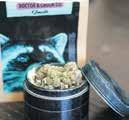
For a $10-a-gram bud, I can’t find anything negative thing to say about it. Doctor & Crook Co. is a self-described “collective of craft cannabis artisans” stationed in Bellingham, and claims to be 100 percent pesticide free.


bought this strain at a shop recently and brought it to smoke at a party at my brother’s place. Everyone immediately noticed the perfumery scents, reminiscent of incense and flowers.
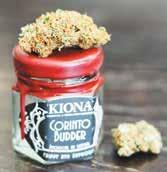
John Careatti, the master grower for Kiona, tells me this strain is a “hybrid of two long-flowering tropical varietals,” Corinto Purple and Puna Budder. The former hails from Colombia’s Pacific Coast, the latter from Hawaii’s big island. Kiona grows biodynamic pot, using botanical oils and beneficial insects to protect the plants instead of industrial chemicals.
After everyone at the party had passed the pipe around, I asked
what effects they were feeling.
My brother said, “It’s uplifting and energetic mentally, but it’s pulling my body downward.” My wife said, “I feel high. I feel it in my head.”
The discussion quickly descended into laughter and giggles, followed by a trip to Ezell’s.
Avitas holds a special place in my heart because the first gram of legal weed I bought in Washington was from this Arlington farm. It is one of the few Washington farms that have been so successful that they’ve been
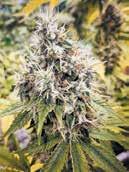
able to expand to other states, and Komodo is one of this farm’s most impressive strains. Jason Smit, Avitas’s grower, tells me that they bred Komodo by crossing a Dragon OG female and a Kimbo Kush male. This is an exceptionally high-terpene plant, at 3.6 percent, predominantly being myrcene, followed by limonene and caryophyllene.
When you handle a nug of Komodo, it is so full of trichomes that the kief just falls off onto your fingers. I brought this elegant-looking strain to a dinner party in Rainier Beach, to accompany a fresh-hopped beer. We shared a freshly ground nug of Komodo between four of us, and we all agreed that it was very strong and had an unmistakable savory lemon flavor.

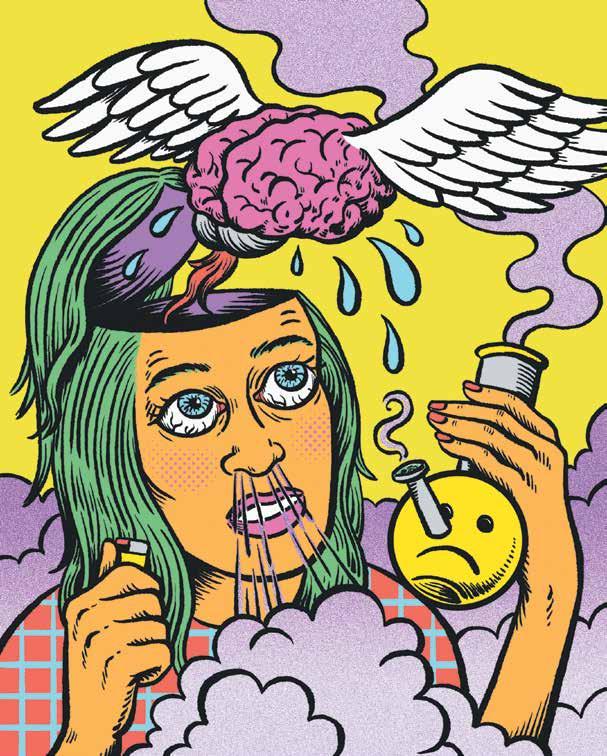
Is cannabis actually bad for your memory? Here’s what the latest science says.
BY KATIE HERZOG
Illustration by Lauren Kolesinskas
If you happened to be reading the UK’s Daily Mail this past July (and, really, who wasn’t?), you may have seen a headline with disturbing implications for the stoners among us.
“Long-term use of cannabis… impairs memory, concludes researchers,” the headline read.
The truth, like most things, is more complicated. Researchers in this particular study found that long-
After 72 hours of abstaining from weed, users’ brains largely bounced back to normal.
term exposure to cannabinoids—the compounds found in weed—led to “significant” memory impairments. These impairments were confirmed by brain scans, which found that memory-related structures like the hippocampus were smaller in research subjects exposed to cannabinoids.
In fact, after long-term exposure, those same research subjects were unable to distinguish between familiar
and unfamiliar objects. It looked like bad news for committed stoners—who wants to forget what a toaster looks like?
But fear not, my stoner friends, because this study wasn’t conducted on humans, it was conducted on mice. And it wasn’t conducted with weed, it was conducted with a synthetic cannabinoid made in a lab and not derived from the cannabis plant. (Mice, however, take note.)
There has been some recent research on cannabis and the human brain, and those findings may actually be something to celebrate.
A 2018 meta-analysis of 69 studies looking at the impact of heavy pot consumption on adolescents and young adults found that while learning, information processing, memory, and the ability to pay attention can be impaired under the influence of weed (duh), the effects aren’t actually long-term. In fact, after just 72 hours of abstaining from weed, researchers found that users’ brains largely bounced back to normal.
But before you load up the bong for a celebratory hit, you should know that another study, this one from 2008, found that adolescents who used weed were associated with poorer cognitive performance than their pot-abstaining
peers. However! A different study, published this year, found that 28-yearolds who started smoking weed as adolescents performed as well or even better on cognitive tests than a control group of nonsmokers.
Who should you believe? The scientists telling you that weed will give you mush brain or the scientists telling you to stop worrying about it?
Neither. Strict government regulations on researching the plant mean we’re further behind in knowing the truth than we should be.
What do regular, heavy users say?
Well, Willie Nelson didn’t respond to my request for comment. And when I reached out to an old stoner buddy of mine who has been smoking weed regularly for the past 50 years, he forgot to call me back.
Clearly, more research (on humans) is needed before we can tell definitively what a lifetime of pot smoke will do to the gray matter. Until then, just watch yourself. Having trouble remembering where you left your keys, where you parked your car, or how you got to work? Lay off the pipe, and science says you should be back to normal after 72 hours. Or, at least, that’s what some of the science says.





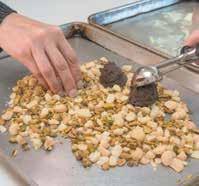
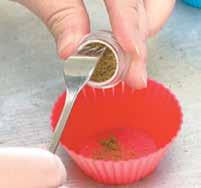


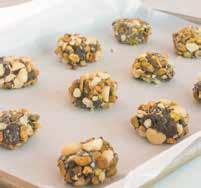








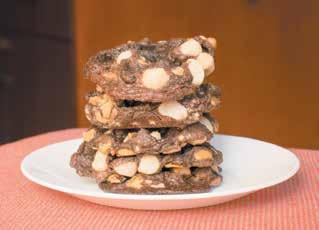
BY LEILANI POLK
Photos by Jessica Stein
My first-ever edible was a pot brownie that tasted like a quarter sack rolled in chocolate. It was the most inelegant edible I’ve ever encountered. A friend’s literally green chocolate-chip pot cookies came in at a close second. (He at least made a rudimentary attempt to filter out the flower.)
The dark-chocolate pistachio macadamia cookies in chef Ricky Flickenger’s new elevated cookbook, Cannabis & the Art of Infusion (published by the Evergreen Market in August), were not only the best edibles I’d ever tasted, but the best cookies— full stop. And you can make them with or without the weed.
I had a really hard time not Cookie
Monster–mawing through the entire first batch. Did I mention all the cookbook’s wheat-containing recipes feature steps on how to make gluten-free
These dark-chocolate pistachio macadamia cookies can be made with or without gluten or weed.
versions? (Flickenger’s sister-in-law is Phebe Rossi of Capitol Hill’s gluten-free bakery Nuflours, and she
was consulted on everything from gluten-free flour brands to measurements to cooking variations.) Did I mention it took only about half an hour to make the infused butter? Did I mention that I actually met Chef Ricky and made the cookies with him, and that I picked up some new knowledge along the way (like how to properly crack an egg, something that’s eluded me in my 38 years of existence)?
This was one of my all-time favorite baking experiences, and it was mainly because of Chef Ricky, who’s made a career of teaching regular folks how to cook.
It’s also that Chef Ricky is warm and affable, and has a seemingly natural ability to put you at ease. Which

might have something to do with his background: He has a degree in psychology and spent the first part of his working life as a counselor in a psych hospital. When
Chef Ricky used to work at Trophy Cupcakes and got the shop onto The Martha Stewart
he moved to Seattle from southern Pennsylvania 17 years ago, he decided he needed a change.
“I’d been cooking and baking for a long time, and I really wanted to try something in the field,” he explains. He worked odd jobs for several years, until he ultimately ended up at the flagship Trophy Cupcakes when it opened in Wallingford in 2007; he was their first employee. He wrote recipes, worked on designs, and even got the shop onto The Martha Stewart Show. “That was all very exciting, but it was a lot of work.” He was putting in 70 to 80 hours a week, helping run the bakery with the owners, but he realized it wasn’t what he really wanted to do.
discovered the therapeutic effects that edibles had on his own anxiety, sleeplessness, and depression. And the effects lasted long after the high wore off.
“The problem was, especially when edibles first came out, a lot of them didn’t taste very good. They were usually made of sugar, and there weren’t a whole lot of savory options.” He was also paying $10 to $15 per edible. Since he was eating them nightly, he thought if he could figure out a good infusion process, he could do it better—and more cost effectively—at home.
Thus his research into using cannabis in his recipes began in earnest, his approach much the same as in his regular food classes. Applying as much food science as he could muster, he worked to separate the facts from the myths about cannabis in the mostly anecdotal information he found, and he began experimenting with different methods.
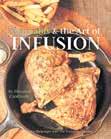
He had a few goals in mind: a short (not hourslong or overnight) process for infusing butter, mayo, sour cream, or oil with weed; minimal to no cannabis smell or flavor, both in the making of the edibles and the results; and a way to take the guesswork out of dosage.
“I really enjoy showing people how to cook, and showing them that anything they see made on TV is something that they can do at home.” After a few years with Trophy, he started his own venture as a traveling chef, a business now called Mortar ’n Pestle. “I go to people’s homes, we do custom menus for everybody, and I give a three- to four-hour lesson on how to cook whatever it is they want.” Go to mortarnp.com to schedule a lesson, whether with cannabis or without.
He started cooking with cannabis roughly four years ago, when he
“That was the number one thing I heard from friends and clients, and learned from my own personal experience—nobody ever knew how to control the dosing,” he says.
Knowing the dosage is especially important when edibles are used for therapeutic or medical reasons, or if they’re being taken by a person because they can no longer smoke but still want to partake. He likens it to taking any over-the-counter drug: “If you’re taking aspirin, you want to know how much is in each pill.”
For his infusions, he uses kief instead of pot flower, and his process involves decarbing the kief

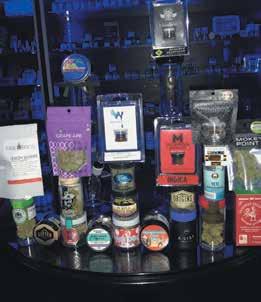



















































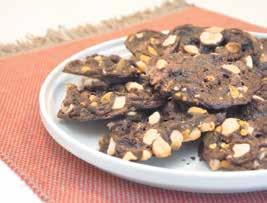
to activate the THC, then adding it to low-heated oil, cream, or butter. He has an entire formula in the book for deducing how much THC will be in the end product… but you’ll have to pick up a copy of Cannabis & the Art of Infusion (at your local bookstore or elevatedcookbook.com) for those details.
I shared the cookies with my stoner colleagues at The Stranger.
He knows for sure that his process is sound, because he had his infusions tested for THC content in a lab. “I wanted to make sure what I was telling people was actually going to happen, that it was accurate. And I do note this in the book: While you can’t get 100 percent decarbed results every time—home ovens vary, temperatures vary—you can get close to that dose every time.”
Once he had his infusion process figured out, he turned to making different types of food, and savory dishes were his top priority. His cookbook features recipes from his own repertoire that he adapted for infusion, and it includes appetizers, soups, salads, and entr é es, in addition to desserts. “These are meals you can enjoy, these are meals you can
appreciate, these are meals you can be impressed by, and still get whatever effect you need.”
His duck confit is featured prominently on the cookbook’s cover. “People don’t see this as being something that’s an edible, because it’s a big hunk of meat,” he says. But he then explains that it’s easy to make (most of the cooking time is spent in a crock-pot), it’s delicious, and there are two different ways to infuse it. “It’s my favorite, because it’s so unexpected.”
But I wanted to make something I could share with other people, to see what they thought, and I fucking love cookies. So we made Chef Ricky’s dark-chocolate pistachio macadamia cookies. They spread a bit because of the gluten-free flour (chilling them for an hour would have prevented this), but the taste was spot-on. And all the people who tried them (including my stoner colleagues at The Stranger) thoroughly enjoyed them.
Results varied from no noticeable effects, to fun and floaty, to a near immediate stoning that went straight to the head and put the person to bed—which just goes to show you that tolerance, weight, and other circumstances all factor into effects. Knowing your edible limits is the best way to proceed with deciding how much to eat, as the effects of eating pot versus smoking it are very different.
But if you want, you can use regular butter instead of infused



butter in the recipe below, and the cookies are just as delicious.
A few days after our baking session (and, yes, we made the version of the recipe that gets you baked), when I had an evening alone, I gobbled two cookies (as previous testing proved that one didn’t quite do the trick), kicked back on the couch, watched an episode of This Is Us, realized it was working when the heartwarming humor made me LOL, and then went up to bed. Despite being a light sleeper, and normally waking up at least a dozen times before morning, I fell into a long, dreamless sleep that lasted the whole night through. Man, did it feel good.
Makes about 4 dozen cookies
• Sharp knife
• Cutting board
• Measuring cups & spoons
• Medium mixing bowl
• Whisk
• Stand mixer with a paddle attachment or a handheld electric mixer
• Silicone spatula
• Baking sheet
• Parchment paper
• Large bowl
• Small cookie scoop or 2 soup spoons
• Cooling rack
2 ¼ cups all-purpose flour (glutenfree variation: use 2 ¼ cups gluten-free flour blend [plus ½ teaspoon xanthan gum if needed])
4 tablespoons unsweetened cocoa powder (Chef Ricky recommends Hershey’s Special Dark Cocoa)
1 teaspoon baking soda
1 teaspoon kosher salt
1 cup (2 sticks) unsalted, infused butter, softened (refer to Chef Ricky’s book for his infusion recipes)
1 ¾ cups packed brown sugar zest of 1 large orange
2 large eggs
1 teaspoon vanilla extract
1 teaspoon almond extract
2 cups semisweet chocolate chips
1 ½ cups roasted macadamia nuts, roughly chopped
1 ½ cups salted roasted and shelled pistachios, roughly chopped
1. Preheat oven to 375 degrees F.
2. In a medium bowl, whisk together the flour, cocoa powder, baking soda, and salt.
3. In a stand mixer with a paddle attachment (or using an electric handheld mixer) on medium-high speed, cream together the butter, sugar, and zest for 5 to 15 minutes. The timing varies depending on the temperature of the room and the butter. (That’s why the recipe calls for softened butter.) The mixture should be light and fluffy.
4. Add the eggs one at a time, thoroughly incorporating each one before adding another, starting on low speed and whipping the egg in a bit before switching to high speed. After the second egg is whipped in, scrape the bottom and sides of the bowl to be sure that all the eggs, butter, and sugar are well mixed. Whip in both extracts. The mixture should be fluffy again when done.
5. Add the dry ingredients and mix on low speed until just incorporated.
6. Stir in the chocolate chips by hand.
7. Mix together the nuts in a large bowl.
8. Line a baking sheet with parchment paper. Using a small cookie scoop or 2 spoons, create balls of dough and place them on top of the bowl of nuts (each ball should be about 2 tablespoons’ worth of dough). Press the nuts into each ball of dough, and then place them on the prepared baking sheet.
9. Bake for 9 to 10 minutes. The cookies will flatten out a bit and be soft. They may seem like they’re not done, but don’t fret—they are. Allow them to cool on the baking sheet for 5 minutes before moving to a cooling rack. The cookies will set upon cooling. Once they’re completely cool, you can freeze them if you like.


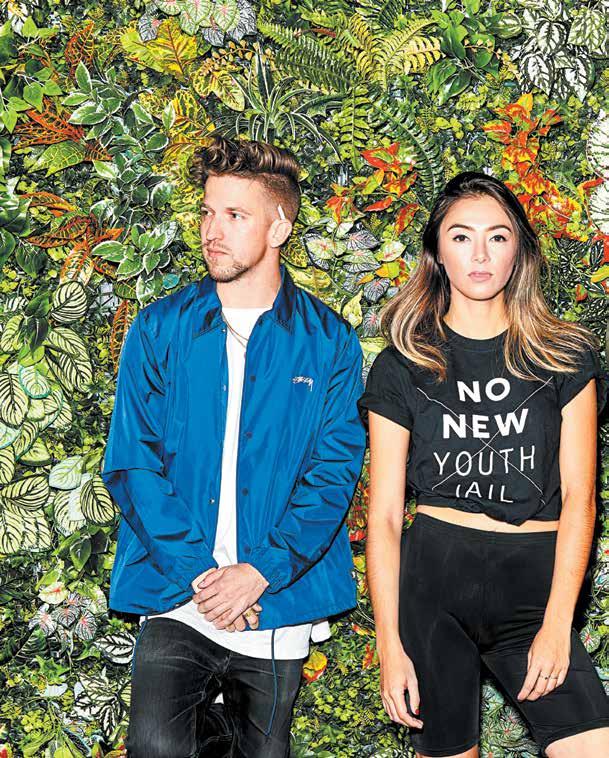


The band’s self-titled strain raises money to right the wrongs of the war on drugs.
BY AJ DENT
Photos by Quinn Russell Brown
There were gold streamers and strings of blue lights in Lux Pot Shop’s parking lot in Ballard. There were people shoulder-swaying to roller disco beats, ping-pong players in the corner, and a giant Connect Four game.
It was the store’s third birthday, and Lux had gone all-out in transforming the outdoor space into a play place any stoner would love. There was free barbecue and coffee ice cream, a pop-up art sale, and a DJ set by the Seattle electronic hiphop trio the Flavr Blue.
Inside the store, a fresh strain of weed was premiering, also called the Flavr Blue. A brand-new hybrid you currently can’t buy anywhere else in the world, it was the reason I’d made the trek out to Ballard.
As a fan of the Flavr Blue’s music, learning they had a self-titled, sativa-heavy hybrid coming out made me eager to try it. The






WONG-WEAR “Social justice acts as an important framework of mind for our artistry.”
strain is a cross of Purple Lemon Haze and Blue Dream, its chemical compounds coming in at 20.2 percent THC and 1 percent CBD. (Blue Dream is also the name of the band’s fourth album, released last fall.) I purchased two of their prerolls at Lux that day, to be tested once I got home.
It wasn’t just out of curiosity.
The coolest thing about this strain is that all net proceeds will be used to fund reparative-justice projects within the cannabis industry. It is the result of a collaboration between the band, Lux Pot Shop (which also has a store in Lake City), Fine Detail Greenway (the grower), and an organization called Cage-Free Cannabis (which started in LA but recently expanded into Seattle).
It’s a collaboration with the grower, the shop, and a social justice group.
Lux’s birthday bash doubled as the release party for the strain.
Unfortunately, when I arrived that evening, I’d just missed the Flavr Blue’s DJ set, but I got to catch up with the band a few days later.
“For us, plugging in with meaningful community engagement is something we’re really keen to do,” said Hollis Wong-Wear, the group’s

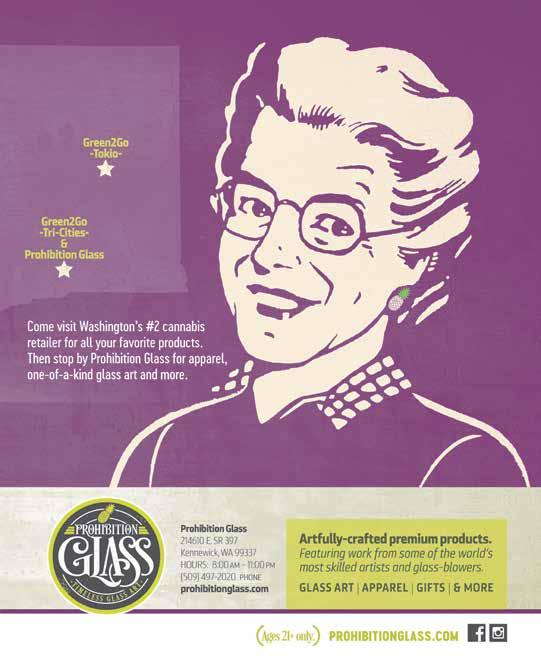

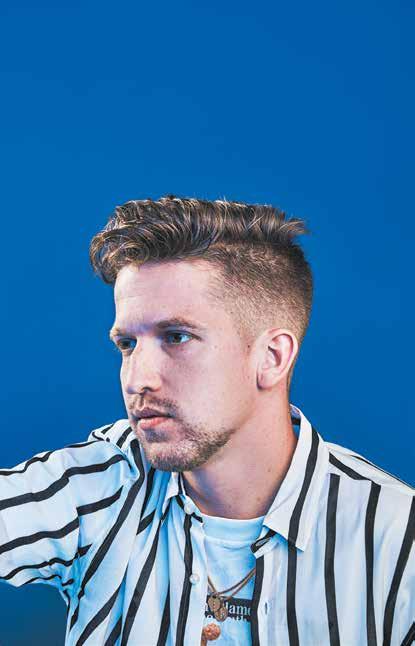
lead singer. “Social justice acts as an important framework of mind for our artistry.”
Her bandmate Parker Joe, a vocalist and producer, said: “Marijuana has always been a thing that we use intermittently in a functional way as part of our creativity. This particular strain reflects a strong sativa lean. We like to be a little more bright and active when we’re smoking, so it fits pretty well with who we are.”
The idea for the strain came from the third member of their band, Isaac “Lace Cadence” Porter. “I’m from the CD, and I’ve seen so many people locked up for weed,” Isaac said. “I have a friend who’s still serving prison time. He had four pounds of weed and he got 10 years. That’s a lot of weed, but it’s not worth 10 years of someone’s life.”
“We like to be a little more bright and active when we’re smoking.”
Isaac thought up the idea for the strain in conversation with Brandon Franks, the vice president of sales and acquisition at Fine Detail Greenway.
“Brandon and Isaac go back a long time,” said Hollis. “It was really just them shooting the shit over some cannabis, and having the idea of maybe naming a strain after the band. It seemed really symbiotic with our music, our brand, our messaging.”
Community service is integral to the band’s dynamic. All three musicians have contributed to and performed for several Seattle nonprofits, including Youth Speaks and the Apex Agency.
Fine Detail Greenway managing director Karen Baker told me: “We’re realizing that this opportunity for [cannabis] to
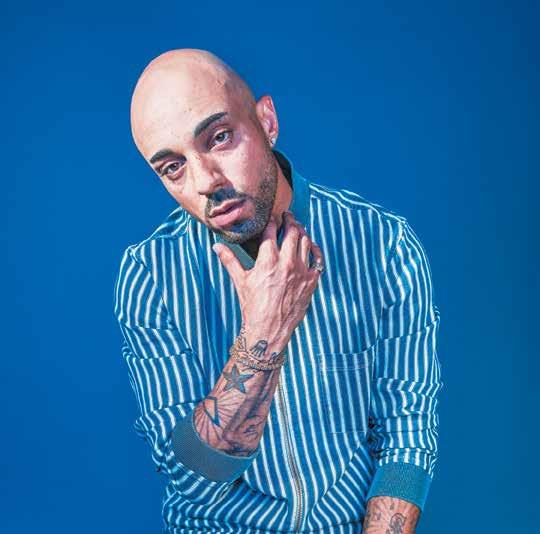
and I’ve seen so many people locked up for weed.”
be legal in Washington has some responsibility that goes with it. For us, some of that is to make sure we’re giving back into our community, or beyond.”
Even before the collaboration with the Flavr Blue, Fine Detail was working in-house toward reparative justice in the industry.
“We hire a lot of people who have faced barriers in their employment, with [criminal] charges,” Baker explained. “We have 16 employees, and I would say a good 11 of them have had difficulties with the law on cannabis.” Pre-legalization, many had lost their jobs or driver’s licenses, leading to additional
financial difficulties. “Those people are all with us, working, and we’ve been helping them go back to school, pay off their fines, do all that stuff.”
While Fine Detail began the growing process, the band approached Lux public-relations director Kalie Sandstrom, whom they knew from previous projects.
Their timing couldn’t have been better. Sandstrom had recently been contacted by Cage-Free Cannabis, a group originally started in California but currently expanding, which has the goal of righting the wrongs of the war on drugs.
“I believe there’s a lot of systemic miseducation about this
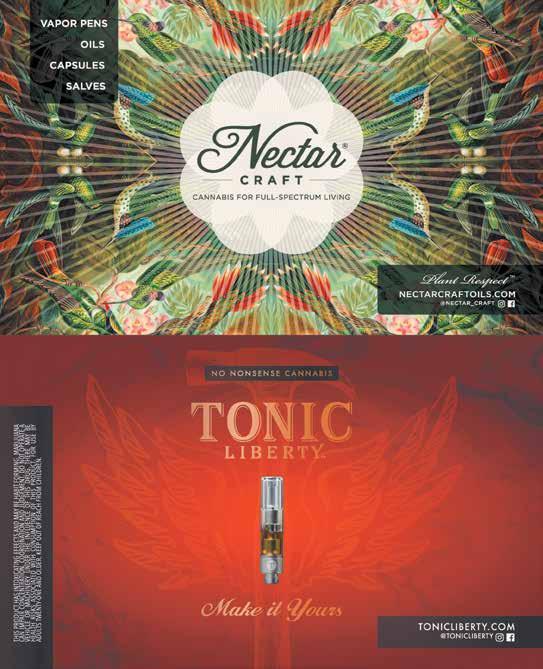

“I think this is a really exciting time to frame what justice can look like in the cannabis industry.”
—Hollis Wong-Wear

plant used specifically to target certain demographics,” said Sandstrom. As opposed to reparative justice, “restorative justice doesn’t really work, because there was never a time period in which people were treated equally surrounding it.”
She points out that drug policy has been racist since the beginning, and that following the abolishment of slavery, “it was used strategically as a tool to incarcerate those same people who had been freed. What we need to focus on doing is repairing the damages that are under all of this.”
Cage-Free Cannabis was quickly receptive to the idea of working together. Cofounders Adam Vine and Andrew Epstein both have backgrounds in working with nonprofits that focus on reentry after incarceration, violence prevention, and youth empowerment.
“This plant, cannabis, has been used to put people in cages for decades.”
The name Cage-Free Cannabis is meant to be “confrontational and aspirational at the same time,” Vine told me. “The Cage-Free Cannabis name connotes both sustainability and quality. But at the same time, we didn’t want to sugarcoat the fact that this plant, cannabis, has been used to put people in cages for decades. So we envision an industry in which people are no longer incarcerated because of this plant. An industry that helps repair the harms done to them.”
Lux was one of several stores Vine contacted during a trip to Seattle this past spring to meet local cannabis entrepreneurs. “A lot of things drew me to Seattle,” Vine said. “I visited because I wanted to see for myself what the cannabis industry looked like there—especially what changes it had created



in different communities.”
He added, “It’s even clearer to me now that the benefits from the emerging above-ground cannabis industry need to be going back to the communities of color that have been devastated by the war on drugs.”
Just a glance into the booming marijuana business reveals a sick, unsurprising truth: Both locally and nationwide, it’s primarily white people getting rich from selling weed, while many people of color are still being punished, still languishing in jail, and still unable to get work even after their sentences are up.
Over the past few decades, for every four black people arrested for pot possession, one white person was—wildly disproportionate to usage rates, which are roughly the
“As of now, it’s going to feature nine people who have been directly impacted by the war on drugs,” said Vine, stating the council will be multigenerational to reflect the decades-long battle.
“We also want it to be geographically diverse, so that different parts of the city are represented. Beyond that, it needs to be multiracial, but with an emphasis on the black and brown communities that have been disproportionately harmed.”
Vine said the council “will have a mandate to foster equity, justice, and repair.” Possible tasks include fostering reentry programs and voter registration. He also noted support for the way Seattle is nationally “taking the lead” on automatically expunging previous cannabis convictions.
During his trip here, nearly everyone Vine spoke to mentioned Nikkita Oliver, who ran for mayor of Seattle in 2017 but didn’t make
“In my mind, it shows who’s really down,” Hollis said. “Which farms and which stores are really about leveling the playing field.”
same. And the Washington State Liquor and Cannabis Board looks at criminal backgrounds to determine eligibility for pot licenses. So the licensing rules dependent on the lack of a criminal record are an extension of the unfairness.
While Washington’s 2012 legalization of recreational marijuana has helped many, Parker noted that it created “a turning point where the entire industry started creating all these barriers of entry for people who were benefiting from it in the past, who actually created the market.”
Elevating people who do grasp these issues is the first order of business for Cage-Free’s Seattle branch. They’re using the strain’s initial proceeds to establish a reparative justice council.
it past the primary. Both WongWear and Sandstrom worked on Oliver’s mayoral campaign, which included pledges for social justice programming.
Vine and Sandstrom confirmed Oliver will be working with CageFree to assemble the council. Those interested in applying for the council are encouraged to contact Cage-Free Cannabis for more information (cagefreecannabis .com/contact).
“In my mind, it shows who’s really down,” said Hollis about projects like these. “Which farms and which stores are really about leveling the playing field for people whose livelihoods were hurt by participating in the cannabis industry pre-legalization. And then you see who’s about it for the money, and



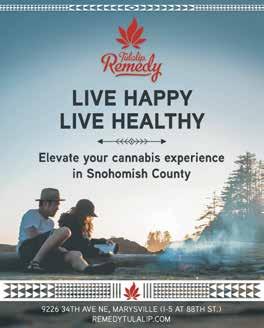

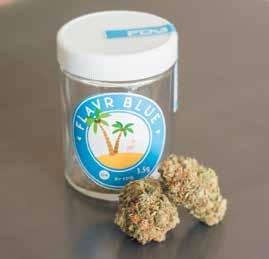
are actually totally OK with perpetuating the racism and the inequality that the current industry presents.”
As for the money raised, where exactly will it be going? Vine said that the nine members of the Seattle Cage-Free council will “be empowered to make decisions not just about how the money flows, but how they themselves are constituted.”
Hollis said, “What I really like about Cage-Free’s model is that, like any reparative justice group should, it gives agency and authority to the people who are most directly impacted.”
Sandstrom said Lux is “totally open to any other accountability measures that people would like to see.” They want to make sure everybody feels comfortable and knows that the money from their purchases is going to the place they say it is. She also encourages other organizations to start working with Cage-Free Cannabis. While the Flavr Blue strain is now available at Lux’s two locations, she’d like to see companies across the state carry it.
2018 Winner of Dope Cup Awards for:
Best Indoor Indica Dominant Flower Platinum Girl Scout Cookies Best CBD Live Resin Extract: CBD Dream








“I just hope this helps other brands and retailers see the potential here to generate funds to help some of the issues we know are very real in Washington State,”
Sandstrom said. “That’s my favorite part of this project—even beyond its shelf life, it’s something that continues to give.”
In addition to pre-rolls like the one I bought at Lux’s party, the strain is available in 1-gram or 3.5-gram recyclable glass jars.
“Normally I don’t like sativas, but because of this hybrid, it’s really a mellow but creative strain,”
Sandstrom told me. “I don’t get any anxiety from it. It kinda has a fruity flavor, so it’s a really enjoyable, smooth smoke.” (After trying out the strain, and as a fellow anxiety sufferer myself, I concur.)
Hollis noted that we have the chance “to model what conscientious consumption looks like as recreational cannabis users. We have an opportunity to be led by those who were most impacted.”
She added, “I think this is a really exciting time to frame what justice can look like in the cannabis industry. It’s a totally new frontier.”



You already know about THC and CBD. Now it’s time to learn your CBGs.
First, a memory: I once rode my bicycle down a winding California road that cut through a stand of eucalyptus trees. I was heading downhill, and the riding was easy. The smell of the warm Pacific Ocean air mixing with fresh flowers and eucalyptus caught my attention. This was more than five years ago, but I can still recall that feeling, that aroma, that clarity.
Oddly enough, this ride through Marin County was exactly what came to my mind as I inhaled a hit of a pot strain called Where’s My Bike? Maybe I remembered it in part because it’s called Where’s My Bike?
Regardless, this vape cartridge full of Where’s My Bike?, made by Seattle’s Heylo Cannabis Extracts, truly did send me back to the memory—not just because of its fresh floral and herbal flavor, but also because of how it made me feel. Just like that bicycle ride was carefree and energizing, Where’s My Bike? gave me a high that was enlivening

and uplifting. I almost hesitate to refer to the feeling as a high. It felt more like the natural energy of working out.
The peculiarity of this mellow high may be caused by a rare compound found in this vape pen that behaves in a very different way than pot’s most famous intoxicant, THC. Heylo’s Where’s My Bike? has a remarkable
amount of cannabigerol (CBG) in it. CBG is a compound found naturally in pot, but it’s rarely encountered in the legal market. Yet it is the mother of all of pot’s intoxicating effects. CBG is the progenitor, the original, the Adam whose offspring is born from its rib. Before compounds like THC and CBD can exist, there must first be CBG.

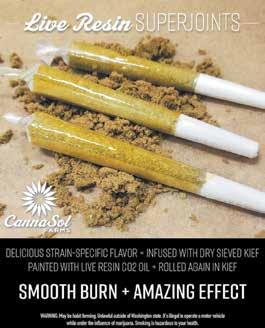



Pot plants create CBG and then turn it into the more familiar cannabinoids like THC and CBD. The plants don’t want to leave CBG as CBG, they want to make it into other useful things, which makes it hard to find this compound in any real abundance, according to Ethan Russo, a medical doctor and one of the world’s foremost cannabis experts.
“It is more or less a way station on the path to these other cannabinoids,” Russo explained.
He told me, “Finding plants that have a lot of CBG has been a challenge. And until recently, there has
There’s evidence CBG can fight cancer and MRSA.
seemingly been very little selective breeding to this end.”
Washington State’s pot market might be the last place to look for plants with high amounts of CBG, considering breeding for CBG essentially inhibits a plant’s THC production. Most legal pot farmers use their resources to grow plants with as much THC in them as possible, hoping that they can entice customers with higher percentages of this intoxicant. This practice floods retail shelves with lots of high-THC options that are essentially all different shades of the same chemical profile.
That business strategy doesn’t make much sense to Heylo CEO Laurel Friesen. She thinks these peculiar strains are exactly where the market should be focusing its energy.
“People resist breeding these strains that are a potential risk because they are worried that the product won’t sell. We’re looking at it the other way—taking a risk is another opportunity to learn something new,” Friesen said.
And with CBG-rich strains like Where’s My Bike?, Heylo might be working on something that could tap into the largest target market for the pot industry: people who don’t smoke pot yet.
CBG seems to have the ability to level out the heavy aspects of THC.
“I think it’s that mood lifter. And it acts like a balancing, grounding cannabinoid where it’s this feeling of euphoria and happiness without making you stoned,” Friesen said. “CBG amplifies the positives of the other parts of the plant.”
Russo said the way our bodies interact with CBG gives it a range of medical benefits, as well as reducing the paranoia-inducing effects of THC.
“It certainly has muscle-relaxing properties, and it may be stronger than THC in this regard. If CBG is a good muscle relaxant, and we know it doesn’t have very strong intoxicating effects, then… potentially that is a really good drug. That same ability may make CBG a really good antianxiety treatment,” Russo said. “It’s easy to understand how having a good component of CBG combined with THC might make it less anxiety-producing.”
There’s also evidence that CBG can fight cancer, gut inflammations like irritable bowel disease, and even that freaky bacterial infection called MRSA. Combine these medical uses with its ability to mellow out a high that might be too overpowering for recreational users, and it could be time to sprinkle CBG on every part of your life. *
Cannabis flowers are not the showiest blossoms on earth. To the uneducated eye, they are just a sticky mass of dense green plant material. Many people find their pungent odor offensive. But for thousands of years, humans have known there was something special inside these lumps of green. We’ve collected them in our gravesites, smoked them in ritual ceremonies, and just generally been enamored with these intoxicating flowers.
It wasn’t until the 19th century that humans started examining the chemical composition of these psychedelic blossoms. And as soon as we applied a scientific eye to these sticky flowers, we found that their intoxicating effects were not the work of just one drug, like the

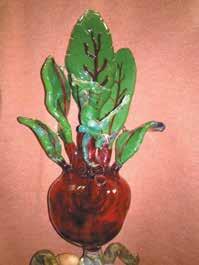





alcohol in beer, but rather a multitude of different chemicals.
It started when British chemist Robert Sidney Cahn isolated and described CBN—a degraded form of THC—in the 1930s. Later came CBD, which was isolated by Roger Adams in 1940 while he was working as a chemist at Harvard. Adams’s discovery of CBD would be one of the last big American scientific breakthroughs on pot, as federal prohibition largely ended cannabis research. But as America buried its collective head in the sand regarding pot, people in other places kept studying it.
In the 1960s, the full picture of pot’s primary constituents started to come into view, thanks in large part to scientists in Israel. In 1964, an Israeli scientist named Raphael Mechoulam advanced the understanding of pot further than anyone before him when he isolated and chemically described THC, pot’s most famous intoxicant. The same year, he published work describing CBG.
His discovery of CBG is far less talked about than his isolation of THC, but it might be just as important, because Mechoulam had discovered the mother of almost all pot compounds.
As mentioned earlier, pot plants produce CBG first, and then use enzymes to change it into dozens of other compounds, including THC and CBD. Most pot plants are really effective at this task—they convert essentially all of their CBG into other chemicals. But some plants, like Heylo’s Where’s My Bike? strain, aren’t very good at finishing the job, so they leave some CBG behind. Heylo’s vape cartridge has roughly 60 percent THC in it and 6 percent CBG, meaning CBG constitutes about 10 percent of the total cannabinoids.
I sent the test results for this vape cartridge to Ryan Lee, president of the Canadian breeding and consulting company Chemovar Corporation. Lee has spent more than 20 years working in cannabis breeding programs, long before the legal market started, and he said this was an unusual strain.
“The Where’s My Bike? sample is interesting,” Lee said over e-mail. “It certainly seems to fall into that rare-ish class of Type 1s where CBG(A) is present at about 10 percent of the total cannabinoid fraction—similar to Trainwreck and Green Crack [strains].”
By Lee’s estimation, this strain is only “rare-ish,” so what, I wondered, would make it truly rare? The truly rare plants leave nearly all of their cannabinoids as CBG, essentially producing no THC. Lee said these plants exist, somewhere.
“I have never heard of one on the Washington marketplace, where the market is driven by THC scores. The marketplace needs educating,” Lee said.
CBG is the mother of almost all pot compounds.
One place where you can find this rare plant in abundance is in the British laboratories of GW Pharmaceuticals, the world leader in cannabis-based medicine. Doctor and cannabis expert Ethan Russo, who was a senior medical adviser for GW Pharmaceuticals for 11 years, said the company was able to use selective breeding to essentially break the enzymes that would normally convert CBG into other compounds.
“This particular plant… has a mutation that it doesn’t have any enzymes to carry the CBG(A) into [other cannabinoids], so it means that 100 percent of the cannabinoids produced in that particular plant are CBG(A) which can then be decarboxylated into CBG,” Russo told me.
He said he encouraged the company to keep studying this CBG plant, but ultimately they focused more on other parts of the plant, including CBD. GW Pharmaceuticals is the only company to get approval from the US Food and Drug Administration for a cannabis-derived drug. It reached this milestone in medicinal pot in June of this year with a drug called








Sativex, which treats a rare form of epilepsy with CBD.
CBG has been studied far less than CBD has. But if you look at the medical evidence we do have, it would appear to have a considerable amount of medicinal potential.
*
Pot’s medical value is what first attracted Laurel Friesen to the weed business. After graduating from Northwestern University with a degree in chemistry, she went to work for a gastroenterology lab at a Chicago hospital. She planned to go to medical school, but then pot’s sticky flowers got in the way of an MD.
The supervising doctor at the lab would frequently point out the potential for pot to be an effective treatment for the patients being treated.
Friesen started spending time in the medical library reading studies from the 1940s and 1950s, before pot was made illegal, and she was shocked to see the medical evidence for pot’s effects.
“I had access to all the white papers and things like that, and once you get past that easiest access stuff that is saying cannabis
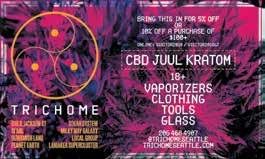

causes schizophrenia, after you get past those, there’s a lot of meat from a long time ago, from… when people were reporting using it as a medicine,” Friesen told me, sitting on a plush couch in the corner of Heylo’s industrial cannabis lab in Seattle.
Friesen also read about the modern American pursuit of pot’s medicine. Driven in part by the prohibition of handling cannabis directly, American pharmaceutical companies have developed synthetic cannabinoids that are created entirely within laboratories to mimic specific pot compounds like THC.
Drugs like dronabinol have won FDA approval for helping AIDS and chemotherapy patients, but almost no one thinks they are as effective as real cannabis. Friesen said looking at these attempts convinced her that creating full plant extracts that preserve both cannabinoids like THC and other compounds like the aromatic essential oils called terpenes was a more effective way to create medicine.
“I recognized quickly that you can’t just go about this like all other pharmaceuticals. It’s time to take it back to natural medicine and let the plant tell us what to do from here.”
As we’re sitting in her facility

in Seattle’s industrial district, a loud droning sound hums in the background. Occasionally the hum is punctuated by a series of loud thuds like a hammer hitting a sheet of metal. Then it’s back to the monotone hum.
That industrial noise is the sound of Friesen making her “natural medicine.” She takes her cues from the pot plant by running cannabis flower through high-tech machinery. The humming sound is coming from a series of metal columns in the center of her facility, about the same height as Friesen herself. Ground up pot is loaded into these machines and mixed with highly pressurized carbon dioxide. This separates the inert plant material from the active chemicals like THC and CBG. After a few hours, those active chemicals are discharged in a substance that looks like thick honey.
Instead of going to medical school, Friesen got a job at a company that makes cannabis extraction equipment, and then she moved to Seattle to start her own processing company in Washington’s legal market. There’s some irony in this career path—by going into the legal weed industry, she is now playing around with chemicals that the medical system has almost no access to, CBG being one of them.
There has never been a clinical study of CBG, no scientist has published a study showing how CBG works with humans, and there are no current federally approved studies. All we know about this compound comes from examining its qualities in test tubes and on animals. But even with these small tests, there have been some tantalizing results.
A 2008 review in the journal Inflammatory Bowel Diseases found that across 51 studies that looked at the effects of cannabinoids on intestinal inflammation, CBG had the largest effect size of any of the studied cannabinoids. Another 2008 study in the Journal of Natural Products found that CBG, along with four other cannabinoids, had a “potent
activity” against MRSA, a sometimes fatal and always freaky bacterial infection that can be common in hospitals.
A 1990 study in the Journal of Ocular Pharmacology and Therapeutics that used cats and rats found evidence that CBG “may have therapeutic potential for the treatment of glaucoma.”
And a 2015 study found that CBG “was extremely active as a neuroprotectant in mice,” leaving the authors to summarize that their “results open new research avenues for the use of CBG, alone or in combination with other phytocannabinoids or therapies, for the treatment of neurodegenerative diseases such as Huntington’s disease.”
Russo noted that CBG is a great example of pot’s ability to treat multiple conditions at once. “We usually think of drugs as having side effects. With cannabis medicines, they often have side benefits Sometimes you can use one drug instead of five—so it’s a very foreign concept to most doctors,” he said.
He gave me an example based on CBG’s apparent ability to fight prostate cancer. “Let’s suppose we have an older man who has prostate cancer. We need to treat him with something. We can say that this [CBG] is a nontoxic molecule, so we can use it in large amounts. We hope it’s going to kill your tumor and it’s going to be relaxing instead of anxiety provoking. It’s not going to make you nauseated. And by the way, it’s an antibiotic too.”
None of the research on CBG has been conducted on humans, but Russo said that isn’t a reason to believe that it can’t be a powerful form of medicine.
“We don’t have any randomized controlled trials of a CBG predominant preparation in humans. There has been some animal work and a lot of laboratory work,” Russo said. “However, we have no reason to think that these are not potentially important treatments that are applicable to humans. It’s just that in the scheme of things, people haven’t gotten around to this one yet.”








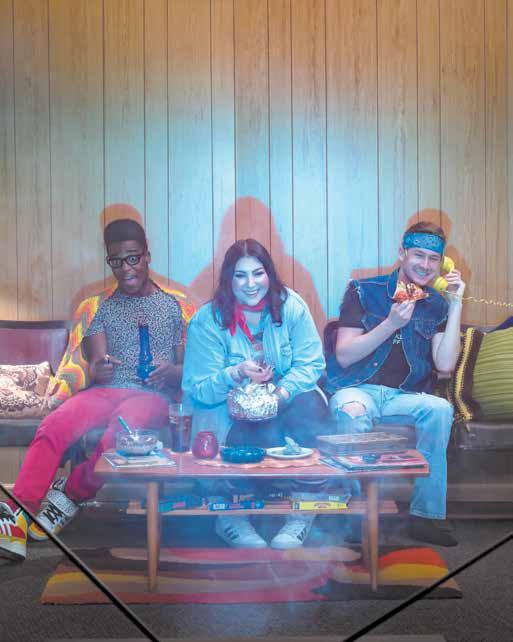



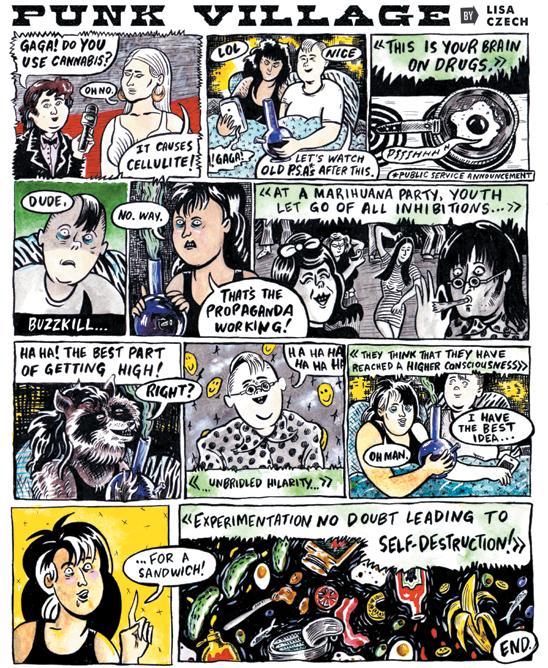
American Mary 5300 17th Ave NW Seattle, WA 98107
206-535-7209
americanmarywa.com
American Mary Medical 5300 17th Ave NW, Ste B Ballard, WA 98107 206-708-7293
americanmarywa.com
Herbs House 716 NW 65th St Seattle, WA 98117 206-557-7388 herbshouse.org
Herban Legends 55 Bell St Seattle, WA 98121 206-849-5596 herbanlegends.com
Ruckus
1465 E Republican St Seattle, WA 98112 206-257-4805 ruckusrec.com
The Reef 1525 E Olive Way Seattle, WA 98122 206-466-6286 thereefstores.com
Clutch Cannabis
11537 Rainier Ave S, Ste A Seattle, WA 98178
206-457-8301
clutchcannabis.com
The Evergreen Market (Ikea District)
4242 E Valley Rd, 2nd Fl Renton, WA 98057 425-332-5246 (Renton Airport) 409 Rainier Ave N Renton, WA 98057 425-318-7331
402 16th St NE, Ste A-100 Auburn, WA 98002 253-218-4177
theevergreenmarket.com
The Joint 14325 1st Ave S Burien, WA 98168 206-242-6000 thejointllc.com
Western Bud Cannabis 11401 Rainier Ave S Seattle, WA 98178
206-257-0663 westernbud.com
Always Greener
Downtown 15937 Redmond Way Redmond, WA 98052 425-861-5497 thegrassisalways.com
Green Theory (BelRed)
1940 124th Ave NE, Ste A-101 Bellevue, WA 98005 425-455-0965 (Factoria) 12827 SE 40th Pl Bellevue, WA 98006 425-502-7033 green-theory.com
Starbuds 11834 NE 90th St Kirkland, WA 98033 425-828-9999 starbud.com
Origins Cannabis 16390 Cleveland St Redmond, WA 98052 425-298-0170 originscannabis.com
Oz. Recreational Cannabis 3831 Stone Way N Seattle, WA 98103 206-251-0630 ozseattle.com
Greenworks 315 N 105th St Seattle, WA 98103 206-492-5132 greenworkscannabis.com
365 Recreational 36711 Hwy 12 Dayton, WA 99328 509-382-3161 365recreational.com
Bloom Cannabis 10707 Pacific Ave S, Ste D Tacoma, WA 98444 253-617-4550 bloomcannabis.com
Green2Go 214307 E SR 397 Kennewick, WA 99337 509-420-0000 2008 Durry Rd Sprague, WA 99032 509-591-7100 green2grec.com
Margie’s Pot Shop 405 E Steuben St Bingen, WA 98605
509-493-0441 margiespot.com
Mary Mart
3002 6th Ave Tacoma, WA 98406 253-507-4735 marymart.com
Remedy Tulalip 9226 34th Ave NE Marysville, WA 98270 360-716-3200 remedytulalip.com
The Joint
1840 James St Bellingham, WA 98225 360-756-0000 9574 Old Hwy 99 N Burlington, WA 98233 360-755-0755
3502 S 74th St Tacoma, WA 98409 253-272-4444 1510 N Wenatchee Ave Wenatchee, WA 98801 509-667-9999 thejointllc.com
Western Bud Cannabis 6186 WA-20 Anacortes, WA 98221 360-293-4200 1401 Iowa St Bellingham, WA 98229 360-933-1133 20291 WA-20 Burlington, WA 98233 360-982-2258 westernbud.com
White Rabbit 15928 Hwy 99 S Lynnwood, WA 425-745-4242
SODO
Cannabis City 2733 4th Ave S Seattle, WA 98134 206-420-4206 cannabiscity.us
Ganja Goddess 3207 1st Ave S Seattle, WA 98134 206-682-7220 ganjagoddessseattle.com
Kush Tourism 3708 Airport Way S Seattle, WA 98134 206-587-5874 kushtourism.com
U-DISTRICT
The Joint 4336 Roosevelt Way NE Seattle, WA 98105 206-283-3333 thejointllc.com
365 Recreational 17517 15th Ave NE Shoreline, WA 98155 206-557-7778 365recreational.com
Bloom Cannabis 11311 Hwy 99 Everett, WA 98204 425-405-6700 bloomcannabis.com Greenworks 11065 Lake City Way NE Seattle, WA 98125 206-922-3911 greenworkscannabis.com
Herb(n) Elements 11013 Lake City Way NE Seattle, WA 98125 206-535-8769 herbnelements.com
American Mary 321 NE 45th St Seattle, WA 98105 206-547-7833 americanmarywa.com
Canna West Seattle 5440 California Ave SW Seattle, WA 98136 206-466-1465 cannawestseattle.com
Mr. Buds 9823 15th Ave SW Seattle, WA 98106 206-397-3618 mrbudswc.com
Origins Cannabis 4800 40th Ave SW Seattle, WA 98116 206-922-3954 originscannabis.com
Pot Shop Seattle 1628 Dexter Ave N Seattle, WA 98109 206-402-6012 potshopseattle.co
Cannador 800-213-6307 cannador.com
Curved Papers, Inc. curvedpapers.com
Greenlake Vapor 7216 Aurora Ave N Seattle, WA 98103 206-525-0381 greenlakevapor.com
Holy Smoke 1556 E Olive Way Seattle, WA 98102 206-323-HOLY
Jupiter Research jupiterresearch.com
Prohibition Glass 214610 E SR 397 Kennewick, WA 99337 209-497-2020 prohibitionglass.com
Seattle Gear Company 2728 3rd Ave S Seattle, WA 98134 206-659-4288 seattlegear.com
Trichome 618 S Jackson St Seattle, WA 98104 trichomeseattle.com
Washington Sun Growers Industry AssociationWSIA washingtonsungrowers.org
BRANDS, PRODUCERS & PROCESSORS
Avitas avitasgrown.com
Cannasol cannasolfarms.com
Clean Green Certified cleangreencert.com
Honey Creek 425-788-0622 facebook.com/honeycreekenterprisesllc1
Mammoth Labs 110 W 6th Ave, Unit 279 Ellensburg, WA 98926 509-968-3030 mammothlabswa.com
Millennium Green 1944 Milwaukee Way Tacoma, WA 98421 253-212-0792 millennium.green
Nectar Craft nectarcraftoils.com
Oleum Extracts oleumlabs.com
Puffin Farm 206-412-0998 puffinfarm.com
Seeds Here Now seedsherenow.com
Stryps strypswa.com
Tonic Liberty tonicliberty.com
Lagunitas Brewing 1550 NW 49th St Seattle, WA 98107 206-784-2230 lagunitas.com
EVENTS & SERVICES
CannaCon 6126 Bothell Way NE Kenmore, WA 98028 425-791-4467 cannacon.org
CanPay Multiple Retailer Locations 877-564-5174 canpaydebit.com canpayapp.com
Law Office of Jeffrey Steinborn 119 1st Ave S, Ste 420 Seattle, WA 98104 206-622-5117 steinbornlaw.com
O’CannaBiz Conference & Expo 905-858-3298 ocannabiz.com
Project STEP Study UW Dept of Psychiatry & Behavioral Sciences 206-685-3617 uwprojectstep.org
POSaBIT, Inc. 1128 8th St Kirkland, WA 98033 855-POSABIT posabit.com
HOTELS
Tokeland Hotel & Restaurant 2964 Kindred Ave Tokeland, WA 98590 360-267-7006 tokelandhotel.com
Sole Mates 1422 Harvard Ave Seattle, WA 98122 206-492-5856 IG: @solemates206
